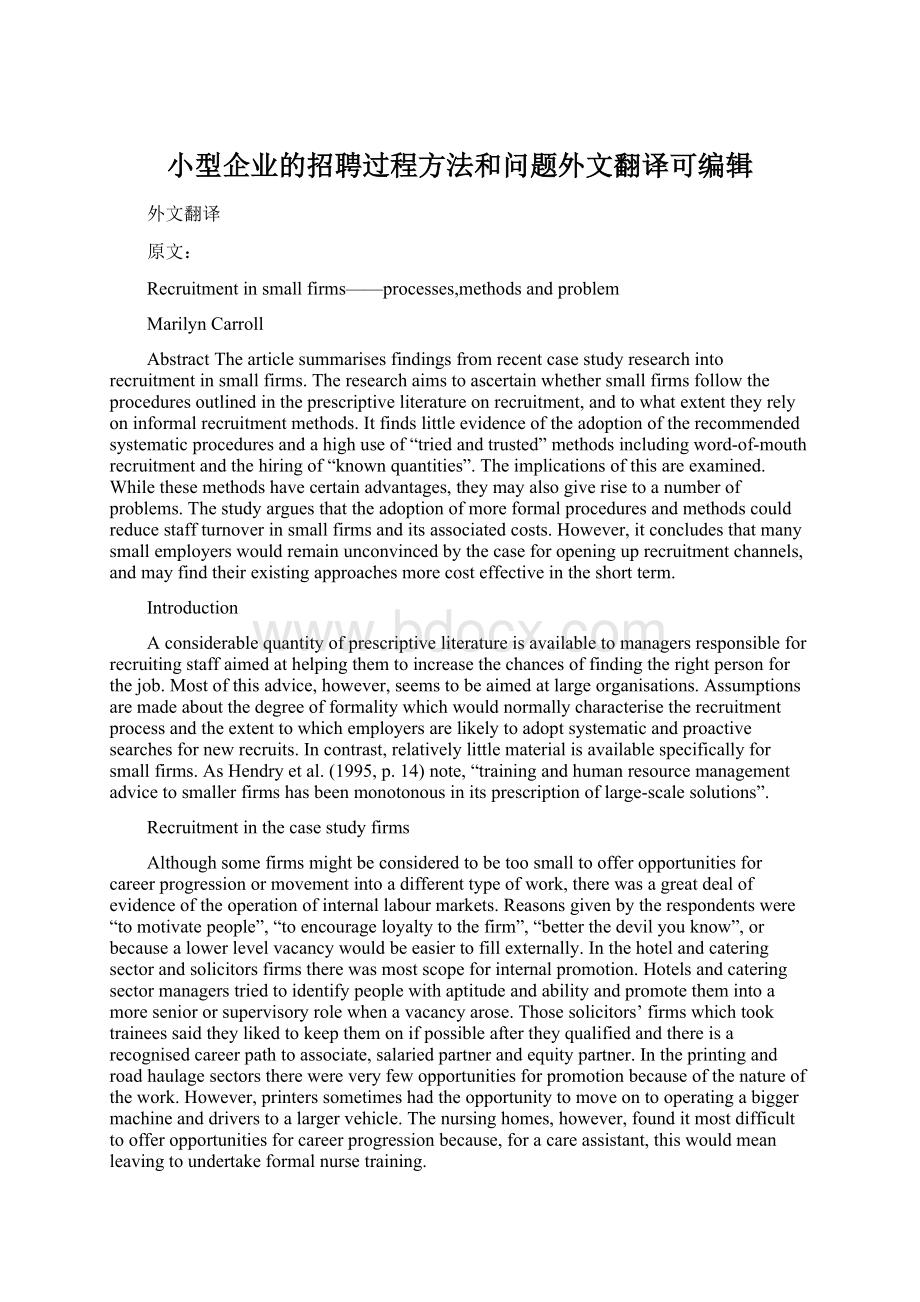小型企业的招聘过程方法和问题外文翻译可编辑.docx
《小型企业的招聘过程方法和问题外文翻译可编辑.docx》由会员分享,可在线阅读,更多相关《小型企业的招聘过程方法和问题外文翻译可编辑.docx(7页珍藏版)》请在冰豆网上搜索。

小型企业的招聘过程方法和问题外文翻译可编辑
外文翻译
原文:
Recruitmentinsmallfirms——processes,methodsandproblem
MarilynCarroll
AbstractThearticlesummarisesfindingsfromrecentcasestudyresearchintorecruitmentinsmallfirms.Theresearchaimstoascertainwhethersmallfirmsfollowtheproceduresoutlinedintheprescriptiveliteratureonrecruitment,andtowhatextenttheyrelyoninformalrecruitmentmethods.Itfindslittleevidenceoftheadoptionoftherecommendedsystematicproceduresandahighuseof“triedandtrusted”methodsincludingword-of-mouthrecruitmentandthehiringof“knownquantities”.Theimplicationsofthisareexamined.Whilethesemethodshavecertainadvantages,theymayalsogiverisetoanumberofproblems.Thestudyarguesthattheadoptionofmoreformalproceduresandmethodscouldreducestaffturnoverinsmallfirmsanditsassociatedcosts.However,itconcludesthatmanysmallemployerswouldremainunconvincedbythecaseforopeninguprecruitmentchannels,andmayfindtheirexistingapproachesmorecosteffectiveintheshortterm.
Introduction
Aconsiderablequantityofprescriptiveliteratureisavailabletomanagersresponsibleforrecruitingstaffaimedathelpingthemtoincreasethechancesoffindingtherightpersonforthejob.Mostofthisadvice,however,seemstobeaimedatlargeorganisations.Assumptionsaremadeaboutthedegreeofformalitywhichwouldnormallycharacterisetherecruitmentprocessandtheextenttowhichemployersarelikelytoadoptsystematicandproactivesearchesfornewrecruits.Incontrast,relativelylittlematerialisavailablespecificallyforsmallfirms.AsHendry etal. (1995,p.14)note,“trainingandhumanresourcemanagementadvicetosmallerfirmshasbeenmonotonousinitsprescriptionoflarge-scalesolutions”.
Recruitmentinthecasestudyfirms
Althoughsomefirmsmightbeconsideredtobetoosmalltoofferopportunitiesforcareerprogressionormovementintoadifferenttypeofwork,therewasagreatdealofevidenceoftheoperationofinternallabourmarkets.Reasonsgivenbytherespondentswere“tomotivatepeople”,“toencourageloyaltytothefirm”,“betterthedevilyouknow”,orbecausealowerlevelvacancywouldbeeasiertofillexternally.Inthehotelandcateringsectorandsolicitorsfirmstherewasmostscopeforinternalpromotion.Hotelsandcateringsectormanagerstriedtoidentifypeoplewithaptitudeandabilityandpromotethemintoamoreseniororsupervisoryrolewhenavacancyarose.Thosesolicitors’firmswhichtooktraineessaidtheylikedtokeepthemonifpossibleaftertheyqualifiedandthereisarecognisedcareerpathtoassociate,salariedpartnerandequitypartner.Intheprintingandroadhaulagesectorstherewereveryfewopportunitiesforpromotionbecauseofthenatureofthework.However,printerssometimeshadtheopportunitytomoveontooperatingabiggermachineanddriverstoalargervehicle.Thenursinghomes,however,founditmostdifficulttoofferopportunitiesforcareerprogressionbecause,foracareassistant,thiswouldmeanleavingtoundertakeformalnursetraining.
Closedsearcheswereamongthemostwidelyusedrecruitmentmethodsinthecasestudyfirms.Allhadusedrecommendationsfromstaff,27percenthadfoundstaffthroughanetworkofcontactsintheindustryand13percenthadpoachedstaffdirectlyfromcompetitors.Oneprintingcompanyhadbeenabletofillallitsvacanciesbythesemethodssincestartingsixyearsago.Employingfriendsandfamilymembersofexistingstaffwasespeciallycommoninthehotelsandcatering,roadhaulageandnursinghomesectors.Theviewwasexpressedthatpeoplerecruitedinthiswayweremorelikelyto“blendin”well.Inthehotelsandcateringsector,especiallyforjobswhichinvolvecash-handling,someknowledgeofthebackgroundofthepotentialrecruitwasthoughtessential.However,afewemployersexpressedreservationsaboutemployingfriendsandfamilymembersbecause“ifyoufalloutwithoneyoulosetwo”.Forsolicitorstherecruitmentoffee-earners“throughthenetwork”waswidespreadincludingofferingemploymenttosolicitorswhohadworkedfor“theotherside”inacase.Thefirmshadampleopportunitiestoassessthecapabilitiesofpotentialrecruits,byobservinghowtheyperformedincourt,forexample.Attitudestowardspoachingstaffvaried.Whilesomeintervieweeswouldpoachstaffwithoutanyreservations,othersregardedthepracticeas“unethical”.AsthemanagerofanIndianrestaurantputit,“ithappensveryoftenroundherebutIdon’tdoittootherpeoplebecauseIdon’tlikeithappeningtome”.Sometimescompetentstaffwere“poachedback”afterleavingtoworkforanotheremployerand,indeed,thehiringofformeremployeeswascommon,especiallyintheroadhaulageindustry,wheredriversoftenmovedaroundfromonecompanytoanother.Inallsectors,apartfromroadhaulagewheredrivershavetobeatleast21totrain,somefirmsrecruiteddirectfromlocaleducationalestablishments.Typicalreasonsforusingclosedsearchesincludedthebeliefthatanexistingmemberofstaffisunlikelytorecommendsomeoneunsuitable,thepreferencefora“knownquantity”,andvaluingsomeonewhowould“fitin”.Onlytwooftheinterviewees(solicitors)expressedreservationsaboutinformal,wordofmouthrecruitmentbecauseoftheequalopportunitiesimplications,andbecauseitwasthoughtpreferabletoconsider“thewholefield”.
Responsiverecruitmentmethodswerealsowidelyused.Overhalflookedatformerapplicationsagainifasimilarvacancyarose.Similarly,overhalfwouldofferworktocasualcallerswhocontactedthefirmeitherbytelephoneorinperson,providedtherewasavacancyandthepersonwassuitable;70percentkeptaregisterofinterestedapplicantsorafileofCVs.Tosomeextent,thisapproachisratherlessproactivethantheothers,relyingonapoolofpotentialrecruitswhohadhappenedtocontactthefirm.Ontheotherhand,itcouldbearguedthattheseindividualsutilisedtheirinitiativeinseekingwork,andmightbeallthemoreattractivetoemployersbecauseofthis.
Ofthemoreformal“opensearch”recruitmentmethods,advertisinginJobcentresandthelocalpresswerethemostcommon.Jobcentreswereroutinelyusedbyalmostallthecasestudyfirms,atleastforsomecategoriesofstaff.TheadvantagesofJobcentresweresaidtobethattheyarefree,andtheadvertisementstaysinuntilthevacancyisfilled.However,whilesomeintervieweesfoundtheJobcentrestobeagoodsourceofnewrecruits,othersexpresseddissatisfactionwiththestandardofserviceoffered.Themostfrequentcomplaintswerethatcandidateswere“notproperlyvetted”,theyfrequentlyfailedtoturnupforinterview,ortheywere“notreallyinterestedinfindingajob”.Fewerfirmsusedotherrecruitmentagencies,mainlybecausetheywereregardedasexpensive.Specialistdriveragencieswerecriticisedbytheroadhaulagecompanies,withonlytwohavingusedthem,andthenmerelyasalastresort.Onceagain,thepeopleontheirbookswerethoughttobe“notproperlyvetted”,inexperienced,ornotlookingforpermanent,full-timework.Althoughmostfirmshadadvertisedinthelocalpress,someonlydidsowhenlessexpensivemethodshadfailedtoproduceasuitablecandidate.Thewholeprocessofadvertising,aninitialtelephonescreening(sometimes),siftingthroughCVsorapplicationforms,shortlisting,interviewing,checkingreferences(possibly)andmakingaselectiondecisionwasthoughttobenotonlycostlyintermsofmanagementtime,butwasregardedasa“hitandmissaffair”.Onlythreefirmshadadvertisedinthenationalpress,andineachcasethiswasa“one-off”tofillamanagementpositionratherthanbeingusedasaregularrecruitmentmethod.Specialistjournalswere,however,morewidelyused,especiallybythesolicitors’firms.Anotheropensearchmethodpopularwiththebarsandpubswasplacinganoticeofthevacancyinthebaritself,whichwasfelthadtheadvantageofattractingthesametypeofpersonastheestablishment’scustomers.Otheropensearchmethodsofrecruitmentusedbythenursinghomeswereplacingnoticesofvacanciesinpostofficesandnewsagentsand,inonecase,advertisingonlocalradio.
Havingreviewedtheextenttowhichthesefirmsfollowedprescriptionsabouttherecruitmentprocessandthemethodstheyusedtoattractstaff,wecannowturntoanassessmentoftheproblemsencounteredinrecruitment.Despiteusingavarietyofmethods,severalofthecasestudyorganisationsreporteddifficultiesattractingstaff.Insomecasesthesedifficultieswerecompoundedbyhighstaffturnoverratessothat,despitetheirsmallsize,thefirmshadongoingrecruitmentdrives,involvingpermanentadvertisementsintheJobcentreand/orregularadvertisementsinthelocalpress.
Noneoftheemployershadactuallycalculatedthedirectandindirectcostsofrecruitmentand,indeed,somesaidtheywouldrathernotknow.Typicalresponseswere“it’sanecessaryevil”and“Idon’tneedanythingelsetohorrifyme”.Althoughseveraloftheemployersadmittedtohavingmadeexpensivemistakes,generallyhighlevelsofsatisfactionwithrecruitmentmethodswereexpressed.Mostemployersusedarangeofdifferentmethodsandmanysaid“Idon’tknowhowelsewe’ddoit”.Wheretherewereproblems,theywerethoughttostemfromashortageofsuitablecandidates,ratherthanrecruitmentmethodsassuch.
Conclusions
Themainpurposeofthispaperhasbeentooutlineandanalysethewaysinwhichrecruitmenttakesplaceinsmallfirms,drawingondatacollectedduring1998fromasampleof40organisationsintheNorthWestofEngland.Theprojectfocusedonfivediverseindustries(hotelsandcatering,